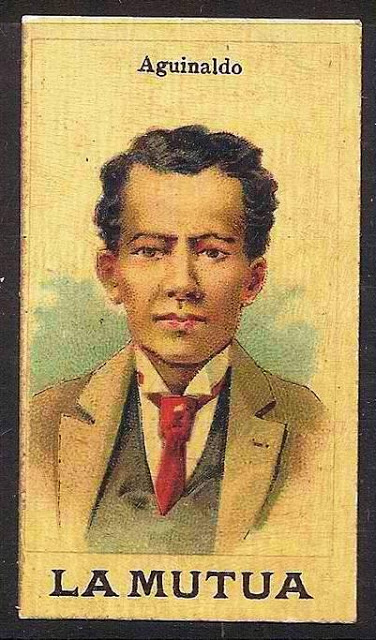Aguinaldo@150
 |
| Cigarette box -- "La Mutua" of Lima, Peru features President Aguinaldo (circa 1900). Lithographic work by Italian engraver and printer Carlos Fabbri. Aguinaldo here with curly hair. |
Whatever depictions about him were, be it a tribal leader or a semi Castilian hero on horseback, Aguinaldo and his war made it to the front page of some of the leading broadsheets of Europe and America. Illustrations of him, no matter how absurd, graced the cover of some magazines. Anti colonialist in the US exalted him, while the imperialist maligned and depicted him as a mere "Asiatic despot in the making". But it is his naivety that often confronts us in the recollections about him as told or written by his peers and those who served under him. The mishandling of the case of the Bonifacio brothers, Antonio Luna, Biak na Bato (which was to some not a pact but a sellout), etc. One could also imagine that scene where allegedly a weeping General Mariano Noriel questioned Aguinaldo -- why he gave the Filipino troop's vantage position in the outskirts of Manila to the Americans, allowing the US and Spain to stage that mock battle.
Can we really fathom or even compare in our time, a leader with such media coverage, of global prominence, who fought against a superpower without the backings of any country or any power whatever? Vietnam had the Soviets and the Chinese to supply them with arms. Aguinaldo did found a sympathetic voice in US public but he never had "personalities", the likes of a media-savvy negotiator as Lê Đức Thọ , not to mention something that of the industrial capabilities of the emerging power that was America.
Did Aguinaldo ever dream of a glorious death? Did he reinvent himself many times after falling from grace? Carlos P. Romulo in his story of the Bataan final stand mentioned a Japanese propaganda broadcast whereby Filipino political personalities were used to speak against America. Aguinaldo lent himself and his voice on that broadcast hitting America's misdeeds in the country and in turn praising Japan. But still, the general lived after that war. In one of his attendance with the president in his final years, he was overheard saying then to President Diosdado Macapagal- "Tulungan nyo po ang mga veteranos ko".
Every morning we raise a flag, we sing an anthem, oblivious perhaps of its meaning. In one of my trips/work abroad as a musician, a Japanese once approached me and told me that he finds our anthem beautiful and moving. I did not take him seriously. What can one say? Its the Philippine national anthem, it exists and it's ours. Yet in a deeper story, these two distinct symbols of our country, flag and anthem, were foremost initiatives of Aguinaldo
History perhaps will never be kinder with the general but one thing holds true, we cannot change anything.
Every morning we raise a flag, we sing an anthem, oblivious perhaps of its meaning. In one of my trips/work abroad as a musician, a Japanese once approached me and told me that he finds our anthem beautiful and moving. I did not take him seriously. What can one say? Its the Philippine national anthem, it exists and it's ours. Yet in a deeper story, these two distinct symbols of our country, flag and anthem, were foremost initiatives of Aguinaldo
History perhaps will never be kinder with the general but one thing holds true, we cannot change anything.
~ Pasig City


.png)


Comments
Post a Comment